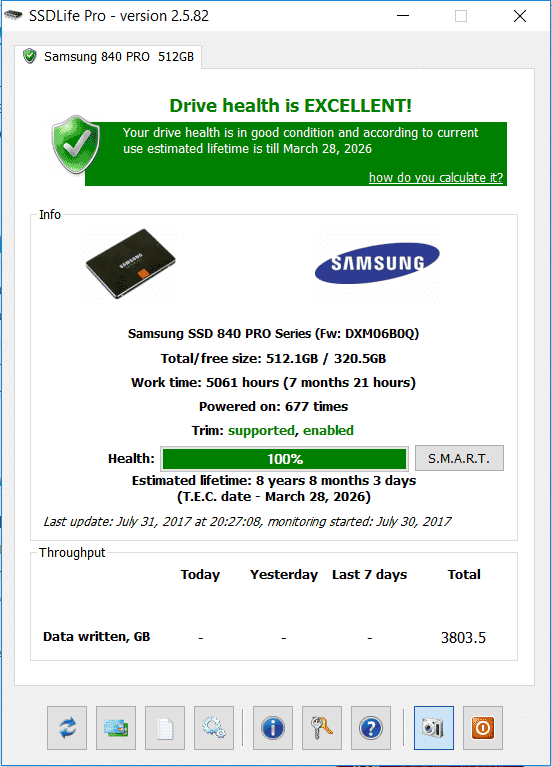

- #Hp ssd health centos how to
- #Hp ssd health centos zip file
- #Hp ssd health centos full
- #Hp ssd health centos windows 10
You can also use it to do some minor adjustments of power management and notifications. You can check firmware updates, port details, buffer size, read and write speeds, power consumption, and S.M.A.R.T information. Of course, general information is also provided.

The issue identified affects specific HPE SAS SSDs with an HPE firmware version prior to HPD7 that are used in a number of HPE server and storage product and results in SSD failure at 40,000 power-on-hours (i.e., 4 years, 206 days 16 hours). It is one of the few free utility tools that have the ability to gather accurate data for both types of storage drives and work with drives from all manufacturers. ISSUE 40K (40,000 Power-On-Hours Failure): In February 2020, HPE was notified by an SSD supplier of a manufacturer firmware defect in certain SAS SSD models used across the industry. Crystal Disk InfoĬrystal Disk Info is open source software which can give you health and temperature information for your SSD or HDD. Last but not least, if you aren’t pleased with the diagnostics results and your benchmarks, you can always optimize your Samsung SSD for your current OS with the OS Optimization feature in Samsung Magician. This will improve the overall performance, especially the read speed numbers. This mode can make use of 1GB of your system’s DRAM as cache for hot data or frequently-accessed data. What Samsung Magician offers through its RAPID mode makes it worth it even more. The Interface field shows either NVMe or SATA, depending on the type of SSD you have.Optimization and diagnostics are just the tip of the iceberg. Step 2: The Device tab displays all vital information about your SSD.
#Hp ssd health centos zip file
Step 1: Download SSD-Z from this official page, extract the ZIP file and then run the SSD-Z.exe file.
#Hp ssd health centos how to
Here is how to use the SSD-Z (free) to check if your SSD is SATA or NVMe. There are plenty of tools out there to give you detailed information about your PC’s hardware, including SSD type. Solution 4 of 4 Check if SSD is SATA or NVMe using a third-party tool We recommend you visit the manufacturer’s website to get accurate information.

Step 4: Now, perform a web search using the model number as the keyword to know if it is an NVMe or SATA SSD. As you can see in the picture, my ThinkPad T480 came with INTEL SSDPEKKF512G8L NVMe SSD. Step 3: In the Performance tab, click on the Disk to see the SSD model number.
#Hp ssd health centos full
Step 2: If you get the Task Manager with fewer details, click on the More details button to see the full version. Step 1: Perform a right-click on an empty space on the taskbar and then click Task Manager to open the same. Z Turbo 4 TB 2280 Gen 4.0 x4 SED OPAL2 TLC M.2 Z2 G9 Mini Kit SSD. 2 TB HP Z Turbo Drive PCIe NVMe Opal 2 M.2 SSD.
#Hp ssd health centos windows 10
Solution 3 of 4 Another way to check if the SSD is NVMe in Windows 10 1 TB HP Z Turbo Drive PCIe NVMe Opal 2 M.2 SSD. If the Bus type is NVMe, the same will show up in the Bus type field. Step 4: The page displays full information about the selected SSD, including the Bus type. Step 3: On the resulting page, right-click on one of the drives to reveal the hidden Properties button. Step 2: In the More storage settings section, look for a link named Manage Disks and Volumes, and click on it.

NOTE: This feature is currently available only for Windows Insiders. Solution 2 of 4 Check if your PC has NVMe SSD via Settings i believe your issue lies within the which mode your in. If your SSD type is NVMe, you will see NVMe mentioned in the Value fields. check your bios settings for either legacy mode or ufei mode, double check the SSD to make sure its still in good health, its just a sanity check since it was recognized in the linux environment. Step 4: Here, in the Property drop-down box, select Hardware IDs. Step 3: Once the Properties dialog is up, switch to the Details tab. You need to right-click on the SSD name, which shows up on the extreme left, as shown in the picture below. Step 2: In the Disk Management window, right-click on the SSD name (refer to the image) and then click Properties. Step 1: Right-click on the Start button on the taskbar and click the Disk Management option to open the same. Check if your PC has NVMe SSD via Disk Management


 0 kommentar(er)
0 kommentar(er)
